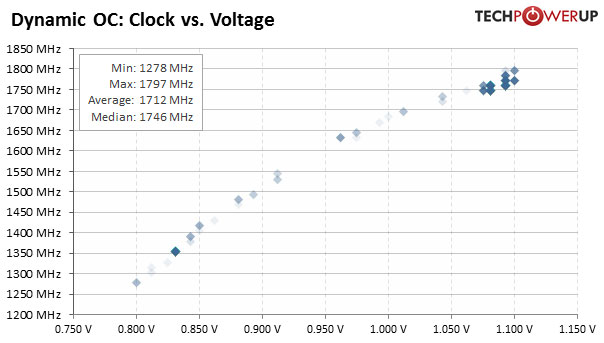 61
61
MSI GTX 1050 Ti Gaming X 4 GB Review
Value & Conclusion »Temperatures

Idle temperatures are excellent even with the fans turning off in idle. During gaming, the card also runs very cool and is super quiet while doing so.
Clock Profiles
Modern graphics cards have several clock profiles that are selected to balance power draw and performance requirements.The following table lists the clock settings for important performance scenarios and the GPU voltage that is used in those states.
| GPU Clock | Memory Clock | GPU Voltage (measured) | |
|---|---|---|---|
| Desktop | 203 MHz | 203 MHz | 0.675 V |
| Multi-Monitor | 203 MHz | 203 MHz | 0.675 V |
| Blu-ray Playback | 645 MHz | 405 MHz | 0.675 V |
| 3D Load | 1278 - 1797 MHz | 1752 MHz | 0.800 - 1.100 V |
For the graph below, we recorded all GPU clock and GPU voltage combinations of our 1920x1080 resolution benchmarking suite. The plotted points are transparent, which allows them to add up to indicate more often used values. A light color means the clock/voltage combination is rarely used and a dark color means it's active more often.

Feb 26th, 2025 19:43 EST
change timezone
Latest GPU Drivers
New Forum Posts
- TECHPOWERUP HWBOT Contest with Cash Prizes (87)
- TPU's Nostalgic Hardware Club (20012)
- RTX5000 Series Owners Club (138)
- VRR Flicker when using Frame Generation (2)
- Help with integrated gpu. (62)
- AM3 build, uses in 2025 (10)
- revisiting hpet bcdedit tweaks: what are your timer bench results and settings? (102)
- The TPU UK Clubhouse (25808)
- Testing max ram overclock pn Ryzen 1700 (82)
- Dune: Awakening benchmark - post your results (28)
Popular Reviews
- Corsair Xeneon 34WQHD240-C Review - Pretty In White
- Corsair Virtuoso MAX Wireless Review
- ASUS GeForce RTX 5070 Ti TUF OC Review
- Gigabyte X870 Aorus Elite WiFi 7 Review
- MSI GeForce RTX 5070 Ti Ventus 3X OC Review
- MSI GeForce RTX 5070 Ti Vanguard SOC Review
- Montech HyperFlow Silent 360 Review
- AMD Ryzen 7 9800X3D Review - The Best Gaming Processor
- MSI GeForce RTX 5070 Ti Gaming Trio OC+ Review
- Montech TITAN PLA 1000 W Review
Controversial News Posts
- NVIDIA GeForce RTX 50 Cards Spotted with Missing ROPs, NVIDIA Confirms the Issue, Multiple Vendors Affected (496)
- AMD Radeon 9070 XT Rumored to Outpace RTX 5070 Ti by Almost 15% (304)
- AMD Plans Aggressive Price Competition with Radeon RX 9000 Series (274)
- AMD Radeon RX 9070 and 9070 XT Listed On Amazon - One Buyer Snags a Unit (247)
- NVIDIA Investigates GeForce RTX 50 Series "Blackwell" Black Screen and BSOD Issues (244)
- Edward Snowden Lashes Out at NVIDIA Over GeForce RTX 50 Pricing And Value (241)
- AMD Denies Radeon RX 9070 XT $899 USD Starting Price Point Rumors (239)
- AMD Mentions Sub-$700 Pricing for Radeon RX 9070 GPU Series, Looks Like NV Minus $50 Again (194)